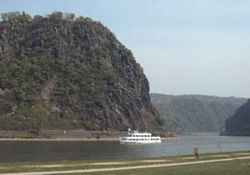Lorelei



The Lorelei (also spelled Loreley) (German pronunciation: [loːʁəˈlaɪ]) is a rock on the eastern bank of the Rhine near St. Goarshausen, Germany, which soars some 120 metres above the waterline. It marks the narrowest part of the river between Switzerland and the North Sea. A very strong current and rocks below the waterline have caused many boat accidents there. Since 1395, the vineyards of the Counts of Katzenelnbogen have been located here.
Lorelei is also the name of one of the beautiful Rhine maidens who, according to a modern legend, sat upon this rock and lured passing navigators to their doom with their alluring singing.
Contents |
Etymology
The name comes from the old German words "lureln" (Rhine dialect for "murmuring") and the Celtic term "ley" (rock). The translation of the name would therefore be: "murmur rock" or "murmuring rock". The heavy currents, and a small waterfall in the area (still visible in the early 19th century) created a murmuring sound, and this combined with the special echo the rock produces which acted as a sort of amplifier, then gave name to the rock itself.[1] The murmuring is hard to hear today owing to the urbanization of the area. Other theories attribute the name to the many accidents, by combining the word "luren" (lurk) with the same "ley" ending, with the translation "lurking rock".
Original folklore and the creation of the modern myth
The rock and the echo it creates have inspired various tales. An old explanation told of the rock as the home of dwarves.
In 1801 German author Clemens Brentano wrote the poem Zu Bacharach am Rheine (part of his novel Godwi oder Das steinerne Bild der Mutter) which first created the story of an enchanting female connected to the rock. In the poem, the beautiful Lore Lay is falsely accused of maliciously bewitching men and driving them to ruin; later pardoned and on the way to a nunnery she passes and climbs the Lorelei rock, watching out for the lover who abandoned her, and falls to her death; the rock still retained an echo of her name afterwards. Brentano had taken inspiration from Ovid and the Echo myth.
Brentano's poem was followed by many other authors who took his story and wrote versions of their own. Most famous is the poem Die Lore-Ley by Heinrich Heine, which tells of the titular female as a kind of siren luring shipmen to distraction with her singing, who then crash on the rocks in the riverbed. Heine's poem was labelled as "written by unknown writer" during the Third Reich because it was too popular to ban it completely for its Jewish authorship.
The Loreley character, although originally created by Brentano, has passed into folklore in her Heine form, and is commonly but mistakenly believed to be an old myth.
References in works of art
Works about, or referencing, the Lorelei:
- The rock bands Tom Tom Club, Styx, Cocteau Twins, the Pogues, Scorpions, Wishbone Ash, Blackmore's Night and Theatre of Tragedy all wrote songs they titled "Lorelei". There are also other songs about Lorelei from worldwide sources.
- Sylvia Plath wrote a poem titled "Lorelei" (published in 1960 with The Colossus and Collected Poems), which many believe draws inspiration from the German legends, perhaps because her father was German.
- Eagle Eye Cherry tells his own version of the myth of Lorelei in his song "When Mermaids Cry".
- The name of Lorelei appears in multiple virtual games, including Tales of the Abyss (game for Playstation 2) and is the name of the song "Die Lorelei" in the soundtrack for the visual novel Fate/Stay night.
Notes
- ↑ Loreley - Ein Beitrag zur Namendeutung. Accessed June 16, 2006.
External links
- The Loreley, a vineyard of the Counts of Katzenelnbogen and their first Riesling of the World
- Text of "Die Lorelei" by Heinrich Heine with English translation
- English verse-translation of Heine's text
- Text of the Poem by Clemens Brentano
- Lorelei Info Information all about the Lorelei
- Lorelei Song mp3
- Article about the Middle Rhine Valley with nice photo gallery (German)